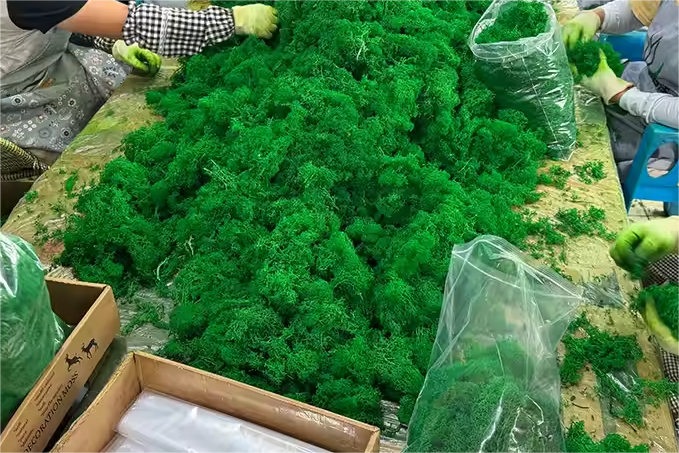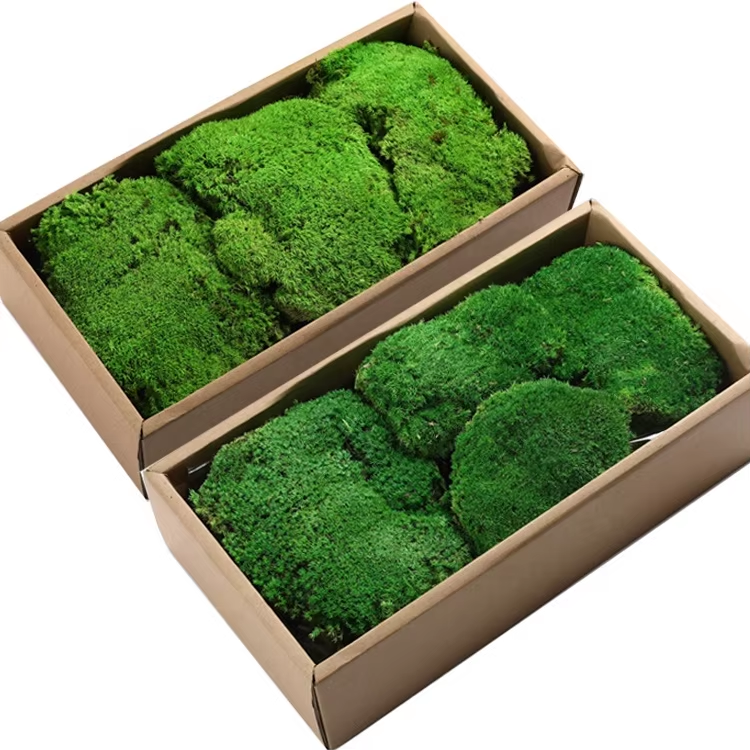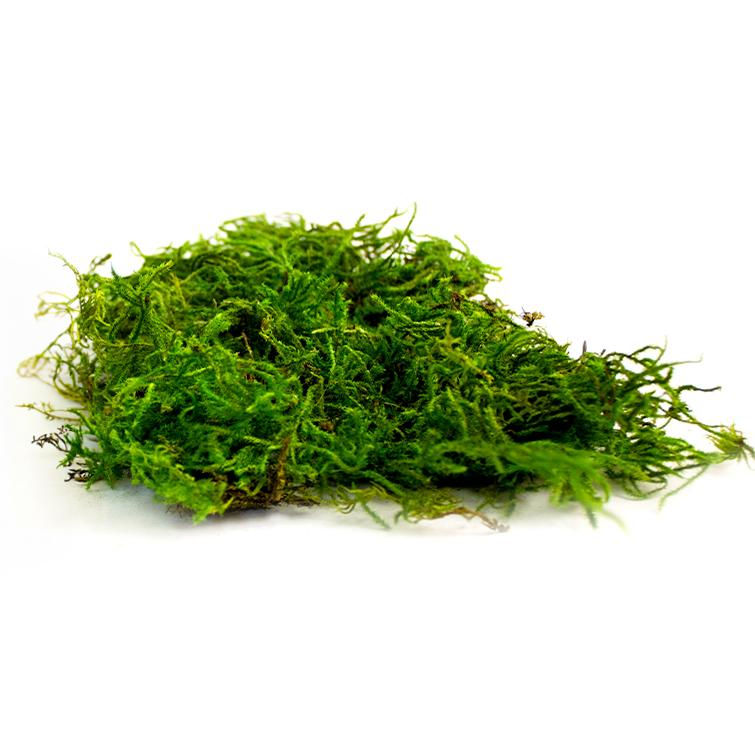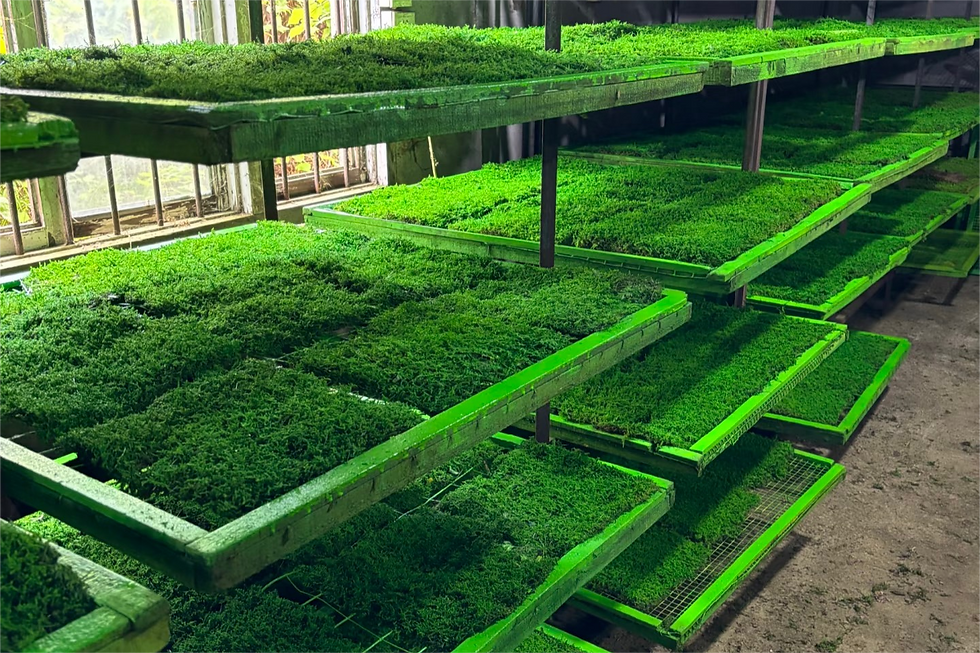What is Preserved Moss? All You Need to Know
- Annie Zhang

- May 28
- 5 min read
Updated: Jun 5

You want natural beauty in your space—but not the headache of live plants. Whether you’re designing an office lobby, building a green wall for a retail brand, or outfitting a luxury hotel suite, one thing is clear: natural textures and biophilic design are no longer just trends—they're expectations. But maintaining real moss in commercial environments is a logistical nightmare.
That’s where preserved moss steps in. It gives you the look and feel of real moss without the maintenance. The problem? Many project managers, decorators, and procurement professionals aren’t entirely sure what preserved moss actually is, how it performs, and whether it’s worth the investment.
So let’s clear up the confusion—starting with what preserved moss really means.
Preserved moss is real moss that has been harvested and treated with a gentle, non-toxic preservation solution to retain its natural look, softness, and flexibility. It no longer grows or requires care. Preserved moss is perfect for long-lasting green decor without watering, light, or soil.
These qualities make it uniquely suited for commercial interior use. Now let’s dig into what sets it apart.
Index:
1. What is the Difference Between Moss and Preserved Moss?
Natural vs. Preserved Moss: A Detailed Comparison
How to Tell if Moss is Preserved?
Preserved moss has a soft, pliable texture but is completely dry. You’ll notice consistent coloring, no visible root systems, and no earthy or musty odor. If you press it and it bounces back like foam, that’s preserved moss.
Can Preserved Moss Get Wet or Moldy?
Water is actually harmful to preserved moss. It disrupts the preservation formula and can trigger mold growth. That’s why high-end installations always use sealed or low-humidity environments for moss displays.
Does It Attract Insects or Lose Color?
No, if you choose a reliable supplier. At Sweetie-Gifts, all our moss is triple-cleaned, soaked in alcohol-based preservation fluid, and dyed with food-grade colorants for long-term visual consistency.
2. How Is Preserved Moss Made?
Preserving moss requires precision. Here's a condensed version of the process we use:
Harvest: Moss is ethically sourced from managed forests.
Dehydration: It’s soaked in 75% medical-grade alcohol to remove water and organic matter.
Second Dehydration: A 99.99% ethanol bath ensures complete moisture extraction.
Fixation: Moss is treated with shape-setting agents to hold its form.
Coloring: It’s dyed using edible-grade pigments in ethanol.
Drying: Finally, it air-dries naturally for 4–6 weeks.
This approach maintains the texture and visual appeal of moss while eliminating any biological risk.
👉Read hear to learn more about How Is Reindeer Moss Preserved?

3. The Benefits of Preserved Moss
Preserved moss offers strategic advantages for B2B clients in construction, interior design, and branding.
Aesthetics: Adds texture, depth, and a natural element to sterile environments.
Installation Flexibility: Works on walls, ceilings, signage, or art panels.
Cost-Efficiency: No irrigation systems, UV lighting, or ongoing maintenance.
Brand Identity: Reinforces sustainable and wellness-oriented design themes.
Sustainability: No overharvesting or chemical emissions.
Want to see real-life use cases? Check out this green design gallery by Plant Solutions—a visual resource often used by architects and decorators.
4. What Are the Types and Uses of Preserved Moss?
Preserved moss isn’t one-size-fits-all. It comes in several distinct types, each harvested and processed from different natural moss varieties. The differences lie in their texture, thickness, color absorption, and structural form, which make each type suitable for different commercial or creative applications.
Below are the four main types of preserved moss used in B2B interior and design projects:
🟢 Flat Moss (also known as Sheet Moss)
What it is: A thin, carpet-like moss that grows flat along the ground and is pressed during preservation.
Features: Smooth, low-profile, uniform surface
Used for: Moss walls, decorative backdrops, brand signage
Best for: Covering large flat areas in office lobbies, retail walls, or minimalist interior designs

🟢 Reindeer Moss (technically a lichen)
What it is: A spongy, bushy plant often mistaken for moss, naturally found in Arctic regions
Features: Voluminous, 3D texture; available in dozens of dyed colors
Used for: Acoustic panels, green logos, product displays, sensory textures
Best for: Office feature walls, boutique interiors, retail packaging filler
Note: It's also the most popular moss in vertical garden installations due to its softness and vibrant coloring

🟢 Pole Moss
What it is: Chunky moss clusters that grow in mounds or “poles” in forested areas
Features: Lush, cushiony, round shapes with natural elevation
Used for: 3D landscapes, biophilic sculptures, organic design accents
Best for: Hospitality settings, eco-luxury environments, and artistic installations requiring natural height and depth

🟢 Forest Moss
What it is: A mix of wild-growing moss with natural debris and textures, often used in a more raw, untamed form
Features: Texturally rich, variable density, visually rustic
Used for: Botanical product packaging, gift boxes, and immersive displays
Best for: High-end retail packaging, museum-style floral designs, or themes that demand a raw, natural look

Most frequently used in commercial projects?
👉 Reindeer moss, thanks to its versatility, soft touch, and customizable colors. It's the designer’s favorite when aesthetics meet function.
5. How Long Will Preserved Moss Last?
Most preserved moss holds up beautifully for 3 to 5 years, sometimes longer if:
It’s kept away from direct sun
It’s in a low-humidity environment
It’s not frequently touched
Maintenance Tips:
Don’t Water It: It's already preserved.
Avoid Touching: Oils from hands reduce its softness.
Keep Out of Sunlight: UV rays fade colors.
Dust Lightly: Use a soft brush or air blower.
Want a second opinion? Check out this in-depth care guide by Verde Profilo, one of Europe’s top moss wall specialists.

6. Choose Sweetie-Gifts for Top-Notch Preserved Moss
With over 19 years of preserved plants expertise, Sweetie-Gifts offers direct-from-factory preserved moss to global B2B clients across:
Construction and renovation companies
Office interior design firms
Corporate gifting programs
Event installation contractors
We supply to major chains like Gifi, AEON, Walgreens, and partner with luxury brands like Dior and Lancôme. Our preserved moss is:
Customizable by color and texture
Consistently high quality with professional packaging
Ethically sourced and certified
Processed in our own facilities in Kunming and Yiwu
Let’s Talk Bulk Orders
Email us at sales@sweetie-group.com to discuss:
Wholesale quotes
Samples and custom colors
Delivery timelines
Application advice for your project
We’re not just a supplier—we’re your behind-the-scenes design partner.

Warm regards,
CEO, Sweetie-Gifts









Comments